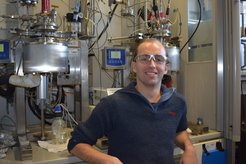Perovskites in oxidation catalysis
Gregor Koch

The multifaceted compositional and structural chemistry of perovskites turns this mineral class into an attractive experimental ground to explore links between solid-state chemistry and catalysis. The concept has been pursued for long time.1 Today, advanced experimental and computational methods are available that facilitate descriptor-based identification of potential catalysts based on a broad variety of materials also for more complex reactions and challenging operating conditions.2
It has been shown in previous studies that the total combustion catalyst manganese oxide can be converted into a more selective oxidation catalyst by embedding MnOx species into a tungsten oxide matrix.3 The concept was developed further in the present work by investigating perovskites that contain various redox active elements in oxidation reactions.
In the present work,4 it is explored whether surface modifications can turn an unselective combustion catalyst into a selective catalyst for the oxidation of propane in the presence of gas-phase oxygen. Manganese-based perovskites AMnO3 (A=La, Sm) were prepared by combustion and hydrothermal synthesis. Bulk and surface structure were investigated by XRD, temperature-programmed oxidation, electron microscopy, Raman, and near ambient pressure X-ray photoelectron spectroscopy (NAP-XPS) in combination with near edge X-ray absorption fine structure (NEXAFS) spectroscopy. Different surface oxygen species were identified based on rigorous in situ analysis of the O1s spectra recorded under a broad range of reaction conditions. The surface concentration of the B cation was varied by the synthesis, revealing that an enrichment of Mn on the surface leads to improved selectivity to the partial oxidation product propene. The valence state of Mn and the surface coverage with various oxygen species depend on the reaction conditions. Increased concentration of OH species and higher abundance of adsorbed activated oxygen in presence of auxiliary steam in the feed lead to the higher selectivity to propene of 50%
with the potential for further improvement.
